
3 Exercises to Perform After An Ankle Sprain
Leave a CommentAnkle sprains are an extremely common lower extremity injury in both athletic and general populations. Ankle sprains account for up to 40% of lower extremity sports injuries1 and are one of the most common injuries to be seen in the emergency room2. Most ankle sprains occur when the ankle “rolls” inward, resulting in pain, swelling, loss of motion, and bruising around the ankle.
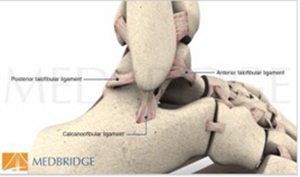 Anatomically, an ankle sprain is an injury to one or several ankle ligaments. 70% of all ankle sprains only involve the anterior talofibular ligament3 near the front and side of the ankle. The calcaneal fibular ligament and the posterior talofibular ligament are involved with more severe ankle sprains. When these ligaments are sprained, the injury is referred to as a lateral ankle sprain.
Anatomically, an ankle sprain is an injury to one or several ankle ligaments. 70% of all ankle sprains only involve the anterior talofibular ligament3 near the front and side of the ankle. The calcaneal fibular ligament and the posterior talofibular ligament are involved with more severe ankle sprains. When these ligaments are sprained, the injury is referred to as a lateral ankle sprain.
If the ligament on the inside of the ankle, the deltoid ligament, is injured this is called a medial ankle sprain. However, medial ankle sprains occur significantly less often than lateral ankle sprains.
Common Injury with Uncommon Consequences
Since ankle sprains are so common, it can be tempting to think of them as minor injuries. Yet ankle sprains can have significant consequences. Up to 40% of ankle sprains can develop chronic symptoms lasting up to 1 year. Approximately 20% of ankle sprains will create chronic ankle instability in which the ankle is not stable during the demands of activity2.
3 Essential Exercises
While many people with ankle sprains experience a smooth recovery, individuals with ankle sprains may benefit from rehabilitation to avoid possible negative consequences. These three exercises are an often essential part of an ankle rehabilitation plan as they address ankle strength, ankle Proprioception and provide a challenge to the ankle functionally.
1. Ankle Eversion – These exercises strengthen the outside of the ankle to improve stability.
- Tip: Make sure the motion is coming from your ankle and not your knee or hip.
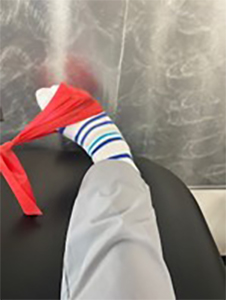
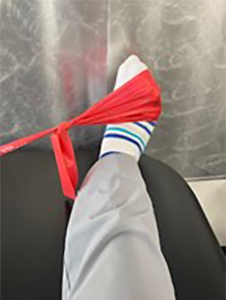
2. Single leg Balance – This exercise trains ankle proprioception which is essential for long-term ankle stability.
- Tip: Start with balancing on the floor and progress to more unlevel surfaces.
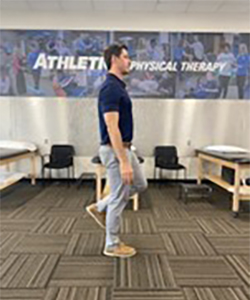
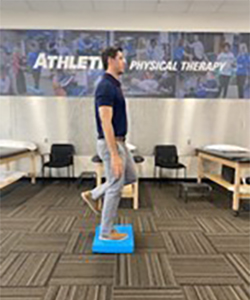
3. Single Leg Balance with Reaching – This exercise challenges the ankle, knee, and hip in a way that replicates daily activities.
- Tip: Start with balancing on the floor and progress to more unlevel surfaces.
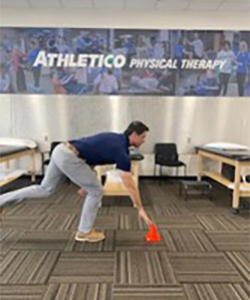
If you have experienced an ankle sprain, contact your local Athletico clinic for a free injury assessment to get a more comprehensive and customized treatment plan. Free Assessments are available in-clinic and virtually through our Telehealth platform.
*Per federal guidelines, beneficiaries of plans such as Medicare, Medicaid, Tricare, VHA and other federally funded plans are not eligible for free assessments.
The Athletico blog is an educational resource written by Athletico employees. Athletico bloggers are licensed professionals who abide by the code of ethics outlined by their respective professional associations. The content published in this blog is for informational purposes only, does not constitute medical advice and should not be relied on for making personal health decisions.
References
1. Halabchi F, Hassabi M. Acute ankle sprain in athletes: Clinical aspects and algorithmic approach. World J Orthop. 2020 Dec 18;11(12):534-558. doi: 10.5312/wjo.v11.i12.534. PMID: 33362991; PMCID: PMC7745493.
2. Mugno AT, Constant D. Recurrent Ankle Sprain. [Updated 2021 Aug 11]. In: StatPearls [Internet]. Treasure Island (FL): StatPearls Publishing; 2022 Jan-. Available from: https://www.ncbi.nlm.nih.gov/books/NBK560619
3. Melanson SW, Shuman VL. Acute Ankle Sprain. [Updated 2022 May 2]. In: StatPearls [Internet]. Treasure Island (FL): StatPearls Publishing; 2022 Jan-. Available from: https://www.ncbi.nlm.nih.gov/books/NBK459212/
